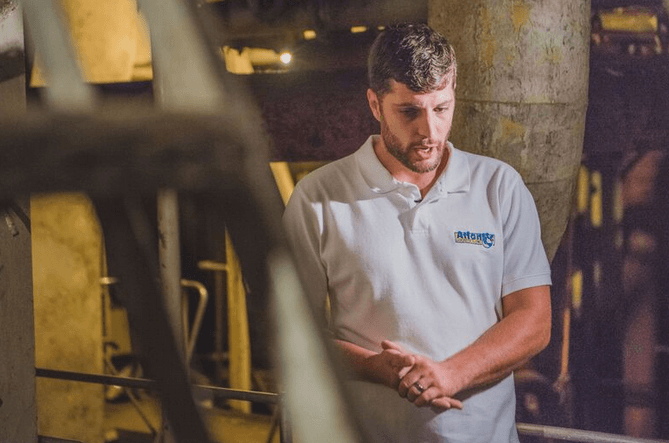Close your eyes for a moment and imagine the SS United States—that’s the hulking, 300-yard long cruise ship that has sat across from the Ikea on Columbus Boulevard for nearly 18 years.
Now imagine what you think the guy whose job it is to take care of it looks like.
Pea coat? Knit cap? Weathered face that moves only to scowl and take pulls off cigarettes?
Wrong.
The caretaker of the SS United States is an an enthusiastic30-year-old man who over the past eight years has come to consider himself honored to work there.
“I can run up and down the SS United States, but I stumble going up the stairs in my apartment,” Ray Griffiths said.
Also, he used to eat his lunch on the top of the ship’s giant stacks.
RELATED:Video: New documentary aims to save SS United States.
The SS United States was built as a cruise ship that could be quickly converted into a troop carrier. Its massive engines — their true capabilities were classified amid the Cold War — pushed the ship toward a record-breaking 3 1/2 day Atlantic crossing during its maiden voyage in 1952. But it was used for only 17 years, taken out of service as jets became a faster and less expensive way to travel over the ocean. For decades, the SS United States was kept in Norfolk, Virgina, where it passed between different owners with different plans that never came to fruition. Its fixtures, furniture and art were auctioned off. One owner moved it to Philadelphia, where it was eventually acquired by Norwegian Cruise Lines, who had plans to restore the ship. When that plan was abandoned, it was acquired by the SS United States Conservancy in 2011, which has struggled to find a developer able to retrofit her into a mixed-use property. Asked what the job of caretaker entails, Griffiths talks a lot about keeping the ship tied securely to the dock.
“If you get it wrong, the ship will move around a lot and start ruining things,” Griffiths said, “mostly the things around it.”
There are mundane tasks — making sure rainwater flows off the deck properly— and complex ones. When he first started the ship listed a bit. He pumped tanks to right the ship. He can talk at length about exploring the lower decks to document aspects of the ship that had been lost. This past Friday, Saturday and Sunday,Griffithsgave tours to reporters — their interest sparked by news that the conservancy could sell the ship for scrap if it does not raise money to pay the $60,000 per month to maintain and insure the ship. Griffiths’ tours are filled with a reverence that he’s picked up from the historians, engineers and enthusiasts he’s met on the job.
“I’ve been fortunate to have met a lot of people,” Griffiths said.
It’s not a job for the faint of heart. There are heights, and there are cramped, dark spaces. He’s escorted a few engineers who have had second thoughts about the danger.
“When I take people on board, I say ‘You need to be honest if you can’t do this,'” Griffiths said.
RELATED:SS United States could get sold for scrap
He’s got his start in the maritime industry at 17, handling logistics for the cruise industry. He did a stint in a trade school for auto mechanics.
But mostly, he’s learned on the job.
“He follows in the tradition of the designer of the ship,” said Susan Gibbs, executive director of the conservancy. She should know, she’s the granddaughter of Francis Gibbs, the self-taught naval architect who designed the SS United States. Ships, however, are also inGriffiths’blood. His dad was the president of Rice and Reynolds, a prominent shipping company.
Officially, Griffiths heads a three-person team that works onboard about one or two days a week. But big storms can change that schedule.
Gibbs said it’s been interesting watching the trio — they’re all about the same age — learn about the ship’s history.
“They’re all young men who have fallen in love [with the job], and the ship is doing great,” Gibbs said.
Gibbs said the conservancy — even as it strugges to pay the costs of maintaining the ship — has never been closer to signing a deal that would see it moved to New York City and developed.
Griffiths wants to see that happen.
“I don’t want it to be forgotten,” he said. “It’s amazing how many people care that I don’t expect to.”
As SS United States faces scrapyard, caretaker talks history and preservation

Maria S. Young


























